 |
||
|
||
| ||
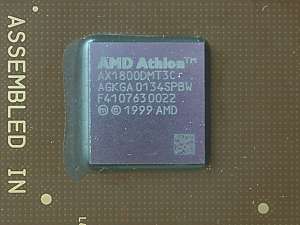 At last we have received a long-awaited processor, namely a desktop version of the AMD Athlon processor built on the Palomino core. The core is not a first on the market, and the AMD's policy of its promotion looks interesting. Usually, a high-end processor is to be released first, then comes its light (budget) version, and then arrives a mobile one. 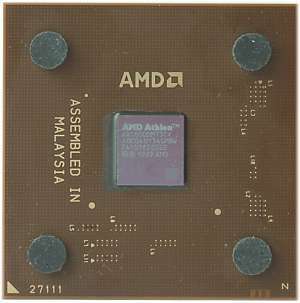 Here it is different. AMD launched first a mobile processor - Athlon 4, then it developed the Athlon MP for dual-processor systems, after that it surprised us with its... low-end processor, AMD Duron based on the Morgan core. The Morgan is actually a Palomino with a smaller cache. 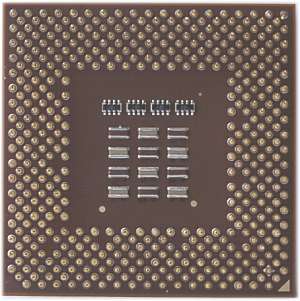 Only after that the market acquired the desktop Palomino known by that time as Athlon XP which got a plastic cover instead of the ceramic one (OPGA, Organic Pin Grid Array) and a reanimated Pentium Rating (later you will find out why we think the PR stands for exactly these two words). While the plastic cover is a logical step, the recovery of the PR is a disputable solution. If you remember the time of ADM K5 and Cyrix processors you know how much the "PR" suffix (marked as Pentium CPU frequencies) was spoken about as though it was equal in performance to the AMD and Cyrix products. The real frequency of these processors was lower than the specified one. To define the Pentium Rating they estimated the performance only in business applications - the field where AMD and Cyrix were strong enough to successfully compete against Intel CPUs even at lower clock speeds. In the calculations with a floating point both AMD K5 and Cyrix 6x86/6x86MX lost to the Intel Pentium working at equal frequencies. And what did an owner of the AMD K5 PR133 get? In business applications it got a performance even higher than that of the Intel Pentium 133 MHz at a smaller sum of money. But, for example, in games the efficiency was at best similar to the Pentium 100 instead of the Pentium 133! Later, starting with the K6, AMD refused it and marked actual core frequencies. And now we are admiring all the same Pentium Rating. Or not the same? Let me examine 3 key aspects of promoting the Athlon XP processor. I will try to ignore the advertising tricks to reveal the naked product. Document 1: QuantiSpeed(TM) ArchitectureAMD divided the basic innovations into 4 items and we will take a look at them. Nine-issue, superscalar, fully pipelined micro-architectureThe pipelined architecture and superscalar features are well known yet from the times of Intel Pentium / AMD K5. AMD places emphasis on the smaller number of pipeline stages than that of the Pentium 4 (which provides for a smaller core frequency) and on a larger number of instructions implemented at a clock. Well, it's true, but at the same time it is not new. Superscalar, fully pipelined Floating Point Unit (FPU)The FPU is really powerful: 3 independent pipelines for implementation of standard FPU instructions of the whole x86 family and of the AMD 3DNow! set, and a complete Intel SSE support (unfortunately, only the first SSE). In fact it is the most powerful FPU for today, but all this was in the K7 core (except the SSE). Hardware data prefetchThe Athlon XP uses a mechanism of preliminary loading of instructions into the L1 cache. There are two interesting points: first of all, it is fair for instructions, not for data; secondly the L2 cache is omitted. In principle, the solution is good as the L1 cache of the Athlon XP (128 KB) is large. And what about the Thunderbird: does it have anything similar? Exclusive and speculative Translation Look-aside Buffers (TLBs)Almost all complicated modern processors do have such TLB. In fact, it is a cache type where addresses of instructions and data are stored. In the Thunderbird a two-level TLB had a capacity of 24/32 (24 instructions' addresses and 32 data's ones) and 256/256. The extended L1 TLB now can store up to 40 data's addresses. By the way, while the Hardware Prefetch optimizes loading of instructions in the TLB the stress is laid on data. Besides, the fact that the L2 cache doesn't duplicate the contents of the L1 one is now applicable to the TLB. In general, it is hard to estimate the contribution of the Translation Look-aside Buffer into the Athlon XP performance, but it is still an advantage. Document 2: AMD Athlon(TM) XP Processor Benchmarking and Model Numbering MethodologyWhen applying the PR again, AMD tries to answer all questions concerning its substance and a forming method. We will touch the key points of this document. And let me start with the applications where the "rating" performance of the Athlon XP can be estimated: Business applications:
Graphics and multimedia:
Games and game benchmarks:
Well, the list is sound. It seems that this time AMD wants to be really objective. Benchmark auditIn fact, AMD claims that it is ready to defend the objectiveness of its rating and has everything necessary to prove its veracity. Processor and Model Number Core Operating FrequencyWell, it tells us at what frequencies the whole Athlon XP series works.
Document 3: Understanding Processor PerformanceThis is actually a more detailed description of what we have already seen in the PDF concerning the QuantiSpeed Architecture. AMD just wants to convince everybody why, on seeing a frequency value of a P4, it is necessary to halve it :) Drawing a conclusionOf course, this rating will definitely put people on their guard. But everybody understands that "the myth about Megahertz" is tough, and AMD has to sell its processors in one way or another. AMD is just trying to gain the solid ground. And now we will dwell on the motherboards on which we estimated the performance of the AMD Athlon XP 1800+. MainboardsHere is a summary table of the parameters:
Shuttle AV40R This board scores the best results in our tests. As it is a production sample it soon will be available on the shelves. A standard box houses a 80-page installation manual, a manual on the IDE Raid controller, 2 ATA66/100 and a FDD cables, 2 brackets with two USB ports each for the rear computer panel and a CD (the drivers, manuals for the board and IDE Raid in .pdf and Adobe Acrobat Reader).  There are some drawbacks in the layout: IDE Raid connectors are behind the PCI slots, an FDD connector is tucked in between the board's edge and the last PCI connector, and audio-ins are located in front of the same slots. The USB 2.0 controller's chip is not unsoldered. There are also 16 capacitors of 1500uF and one switch which clear the CMOS. The BIOS is based on the v.6.00PG from Award and offers a wide range of settings for memory and an AGP bus, manual distribution of interrupts among PCI slots, changeable voltage supplied to the chipset, memory and core. You can also change a FSB frequency and a CPU multiplier. This board looks attractive; it offers quite a lot of functions and demonstrates a decent performance. MSI 850 Pro5 The board from the mobo giant is made on a red piece of textolite. It is interesting that one of the memory slots is turned at 90 degrees to the others. But the most intriguing is that such a large board houses only 4 PCI slots, though you will hardly a board of such format with less than 5 PCI slots. In the florid box we have found the following accessories: a detailed board's description, ATA66/100 and FDD cables, D-Bracket (a bracket with 2 USB ports and 4 LEDs for realization of the D-Led technology), a short description of the D-Led technology, 2 C-RIMM modules, a SmartKey with an extender and a CD. The latter contains drivers for motherboards and video cards from MSI, Adobe Acrobat Reader, AMI and Award utilities for working with the Suspend-To-Disk function, WinFlash from Award for updating of the BIOS right from Windows, proprietary programs such as LiveBIOS and Fuzzy Logic 3, a PC Alert for monitoring temperatures and fan speeds, GoodMem for deleting unnecessary programs from the memory, X-Setup, PCCillin 2000, 3Deep for adjusting a color balance and VNC (for a remote computer access). 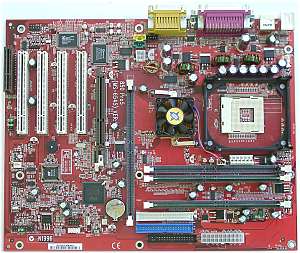 The layout has some imperfections: IDE andFDD connectors are placed too close to each other. There are 8 capacitors of 2200uF and 3 ones of 1500uF. It is interesting that there are two connectors for external USB ports instead of a traditional coupled one. When we first started the computer the fan refused to work, though there is not much need in it. We checked it and found out that it is the board that should be blamed. Besides, the board uses a 2Mbit BIOS instead of the standard 4Mbit one. There are several switches: for clearing the CMOS, FWH recording protection, for changing the memory voltage (2.5 (at default), 2.58 and 2.68V) etc. The BIOS based on the Award Modular BIOS 6.00PG. In our lab we use a preproduction sample of the Intel Pentium 4 with an unlocked multiplier that is why the first thing we decided to do was to set the required multiplier. At x20 the processor worked only at 1.9 GHz. At X21 everything was OK - 2 GHz. We obtained a new version of the BIOS from the company's site where they said the bug was fixed. But after installation of the BIOS 1.1 nothing changed... In all other respects, there is not much interesting in the BIOS: some memory settings, adjustable processor voltage and FSB frequency. This board has both advantages and downsides which you should take into account when choosing a candidate for your computer. DFI NB72-SR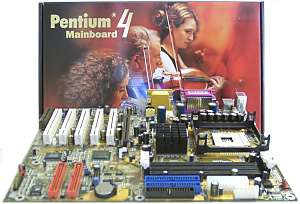 A standard box contains the board, a user's manual in English, French, German and Spanish, an installation manual for the IDE RAID, a diskette with drivers, ATA66/100 cables, an FDD one and a CD. The latter comes with drivers, a user's manual in .pdf, Adobe Acrobat Reader, Winbond Hardware Doctor and PCCillin 2000. 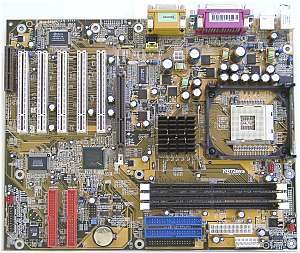 The soldering is of high quality, but there are some tiny drawbacks in the layout, for example, IDE Raid connectors are located behind the PCI slots - if full-sized expansion cards are inserted it is difficult to handle cables for these connectors. The board features 15 capacitors of 2200uF. There are several switches: one is for clearing the CMOS, two can help you start up the system with the PS/2 & USB devices; and the last one sets the basic FSB frequency - Auto, 100 or 133 MHz. The BIOS is based on the v.6.0 from Award and offers a wide range of settings for memory timings and an AGP bus, manual distribution of interrupts among PCI slots, unimpressive changeable multiplier and FSB frequency (in 1 MHz steps). It is a stable board which suits for a great deal of tasks - it is a bit cheaper than its competitors but has an excellent operating speed and plenty various functions. Epox 8KHA+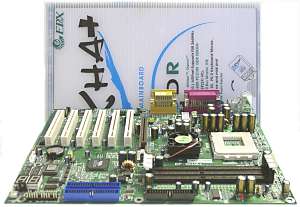 The company has just added "+" to the board's name demonstrating a higher performance of the new chipset from VIA. It differs from its predecessor 8KHA only in the chipset and in a higher-quality AC'97 codec from Avance Logic. The today's board packed in a semitransparent plastic box is supplied with 40- and 80-conductor cables for IDE devices, an FDD cable and a bracket with two additional USB connectors or the rear computer panel. A thick board description gives you all necessary instructions for installation of the board and drivers. A folding short manual is written in 6 languages. Besides, there is a CD with drivers and a modest set of freeware programs, among which are Adobe Acrobat Reader 4.05, Norton Antivirus 2001, PCCillin 2000 and Norton Ghost 6.03. Besides, there is a utility for measuring a processor frequency from DOS or Windows - Boostek. 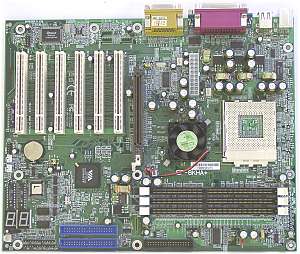 CD-in and AUX-in connectors are placed in front of the first PCI slots - it has nearly become a standard for the manufacturers, but it isn't convenient for assemblers. Besides, the company has decided to save on plastic for these connectors. The cables will undoubtedly fall out from such connectors. On the other hand, there is a clamp on the AGP connector and an AAVID's cooler on the north bridge of the chipset. Besides, there are two standard 7-segment LEDs for monitoring the POST procedure. The codes displayed on them are described in the manual. The feed circuits have 12 LowESR capacitors of 2200uF each. 2 switches are meant for clearing the CMOS and for choosing the base frequency - 100 or 133 MHz. All other settings can be made from the BIOS Setup. The BIOS is based on the v6.00 from Award and includes a great deal of possibilities for adjusting memory timings, AGP and PCI buses operation and a possibility to distribute manually interrupts among PCI slots. The FSB frequency can be changed from 100 to 200 MHz in 1 MHz steps. The core voltage can be changed +/- 0.1V in 0.025V steps and the memory voltage can be lifted by 0.7V from the rated value in 0.1V increments. The board is attractive at first sight but let's wait for similar models to return a verdict. TestsTest equipment:
Software:
Diagrams and commentsSince one of the topical issues of these tests is comparison of the old core (Thunderbird) with the new Palomino, the Athlon Thunderbird 1533 MHz vs. Athlon XP 1800+ (Palomino 1533 MHz) will be commented on separately in italics. At the end we will clarify for which processor such a notorious rating is calculated. Game tests3DMark 2001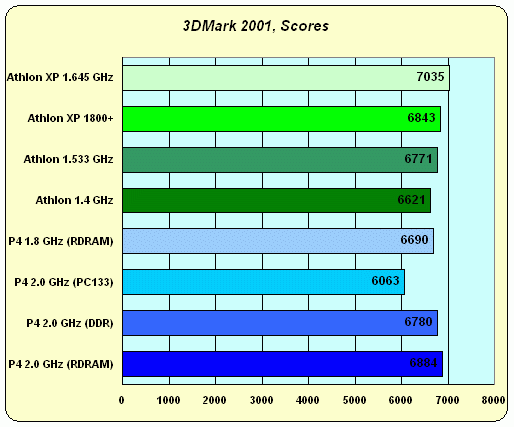 On the whole, the performances of all systems but one are very close. We set the low detail mode, i.e. the video card load is minimal. The only loser - i845/PC133 based system shows that at such a frequency the performance is limited by the memory subsystem. At the same time, the overclocked Athlon XP outscores the Pentium 4 2.0 GHz + i850 which can't win even with its fastest dual-channel PC800 RDRAM. In case of the Pentium 4 + RDRAM vs. Athlon XP + DDR we see that the memory speed suffices in both cases, and it is the CPU speed that matters most of all. 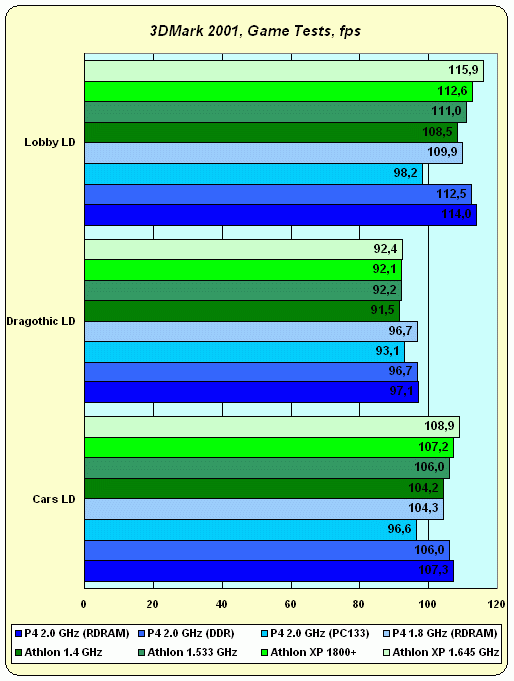 It is interesting that in Dragothic the Pentium 4 even with the PC133 outdoes all Athlons! The only advantages of the Pentium 4 + PC133 in comparison with the Athlon + DDR is a SSE2 support. That is why it has turned out that the SSE2 is more important in this test than other parts of the CPU and memory subsystem. The performance of the old and new cores are almost equal. Why didn't even the SSE help here? There are two possibilities: either SSE doesn't suit the 3DMark 2001 which needs SSE2, or the 3DMark 2001 just can't identify the SSE in the Palomino. Quake III At last the Athlon XP is able to outclass the upper Pentium 4 in the Intel's favorite test! It is interesting that there is a vivid step between the performance levels of the neighboring Athlons. It means that the speed of the PC2100 DDR is enough, and the performance of the CPUs is growing in proportion to the core frequency without being limited by the memory. The Athlon XP 1800+ obviously wins, approximately by 5%. It is too little to base calculations of the rating on the performance of the Thunderbird in comparison to the Palomino as 1800 / 1533 ~= 17%, certainly not 5. Unreal Tournament and Expendable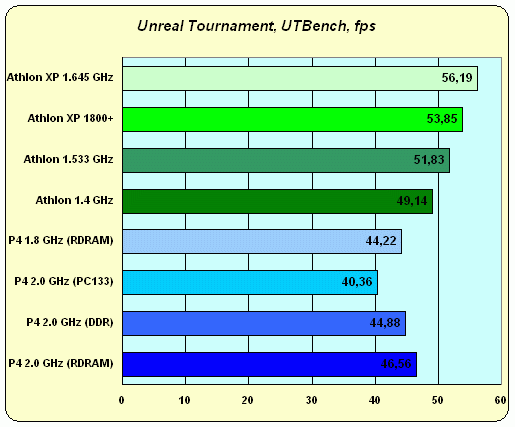  It is interesting that the results of the Unreal Tournaments and Expendable are very close if we don't take the figures into account! It is clear that in Expendable the Pentium 4 loses to the processors of the old architecture because of a "chaotic" code of application, and if we divide the results of the Expendable by a certain coefficient we will get those of the Unreal Tournament. It just means that both applications are inconvenient for the Pentium 4 to a greater or lesser extent. The situation is completely the same as in the Quake III. Business applicationsZD Winstone 2001 As you know, the eTestingLabs tests use the applications more beneficial for the old architecture and less for SSE2 optimized programs. In the business part the Thunderbird overclocked up to the Athlon XP 1800+ level shows almost the same performance, but in the Content Creation it falls far behind. What is guilty? I think it is the SSE which is supported by the Palomino. BAPCo SYSmark 2001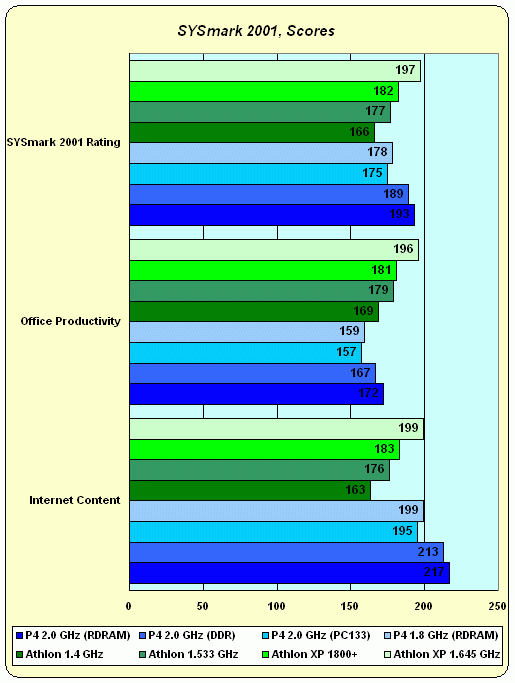 In the business part the results are similar to the Winstone 2001, but in the Internet Content Creation the Pentium 4 is soaring. If we again take a i845 based system with the slow PC133 we will see that the Athlon XP 1800+ comes forward! It means that the SSE2 is really good and usable instruction set. But in the general rating of the SYSmark 2001 the picture is evener, and Athlon XP 1800+ working at the rated frequency almost catches up with the Pentium 4 2.0 GHz + RDRAM. Again the Palomino's performance is higher only in the Internet Content Creation. I think the reason is the same. Workstation applicationsSPEC ViewPerf The AWadvs-04 (Alias|Wavefront Advanced Visualizer) is considered a test of the texturing speed, i.e. the processor's aim is not to prevent a video card from operating at its full speed. On the one hand, we can see that the processors working at different frequencies perform very close. On the other hand, the Athlon has this speed a bit lower, even if we compare with the Pentium 4 + PC133. It is possible that either Intel has a better AGP or the Detonator drivers are developed with the SSE2 in mind. At the equal frequencies the Thunderbird and Palomino score equal results. 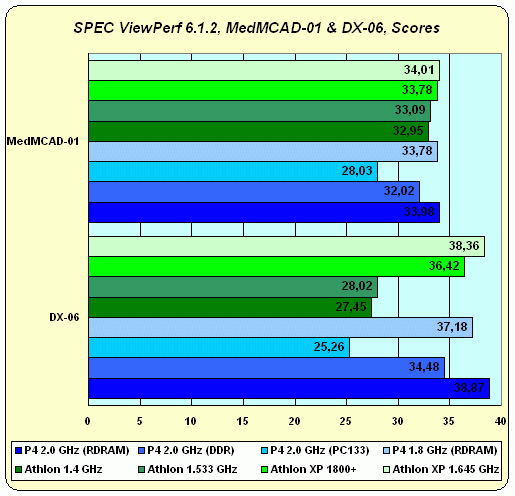 Here we can see a vivid difference between the systems equipped with different memory types and between the Thunderbird and Palomino cores. The PC133 obviously slows down the Pentium 4. The Pentium 4 1.8 GHz + RDRAM work faster than the Pentium 4 2.0 GHz + PC2100 DDR on the VIA P4X266. It is interesting that the Thunderbird 1533 MHz loses to the Athlon XP 1800+ by 30% at the equal frequencies! Hardware Prefetch? TLB optimization? Or 3DNow! Professional which is, in fact, 3DNow! + SSE? The most important is that sometimes the Athlon XP wins from the Athlon on the old core by a significant margin. 3DStudio MAX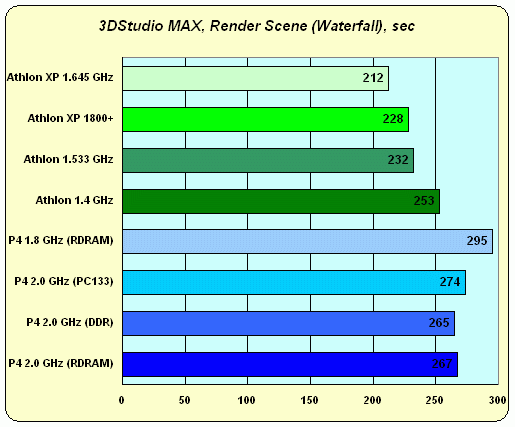 The 3DStudio MAX doesn't like the Pentium 4 much. The result of the battle of Athlon 1533 MHz vs. Athlon XP 1800+ is quite interesting. As far as I know, there is no any optimization of the rendering mechanism of the 3DStudio MAX for SSE, the victory of the latter can be explained by the Hardware Prefetch and new TLB. ConclusionWell, the race keeps on, prices are falling down which is very beneficial for us, users. The Athlon XP 1800+ is a reasonable answer to the Intel Pentium 4 2.0 GHz. Soon this respond will be followed by an Intel's one, then by AMD's one and so forth... As far as the rating estimation is concerned, I think it is closer to the real frequency of the new Intel CPUs, i.e. "AMD Athlon XP 1800+ is like Intel Pentium 4 1.8 GHz only a bit faster". That is why we called this figure Pentium Rating. But the time changes, and this time to the best: if we take the Pentium 4 core's frequency as a real equivalent, this will be a correct rating which refers not only to business applications but also to games and complicated computational problems. P.S. or "working on errors "Well, the race keeps on, prices are falling down which is very beneficial for us, users. As it turned out, in course of making the review we have made one slip. But it is not only our guilty, Microsoft also had a hand in it :) The Windows Media Encoder can't determine whether the SSE is supported by AMD processors based on the Palomino core. That is why the SYSmark 2001 Internet Content Creation results for the Athlon XP 1800+ are possibly a little understated, and it should be taken into account. Nevertheless, these results reflect the current situation. We don't think the Windows Media Encoder is the only program which couldn't detect the SSE support of the Athlon XP. Of course, now many manufacturers facing such problems will start releasing patches for their products but this process is not momentary. Moreover, I consider that in some cases the patches will be released only for the latest versions of programs, while the older ones will be obviously left on the Athlon XP "without the SSE". By Vladimir Rybnikov and Dmitriy Mayorov
Write a comment below. No registration needed!
|
Platform · Video · Multimedia · Mobile · Other || About us & Privacy policy · Twitter · Facebook Copyright © Byrds Research & Publishing, Ltd., 1997–2011. All rights reserved. | |||||||||||||||||||||||||||||||||||||||||||||||||||||||||||||||||||||||||||||||||||||||||||||||||||||||||||||||||